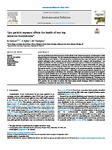Tyre particle exposure affects the health of two key estuarine invertebrates
| dc.contributor.author | Garrard, SL | |
| dc.contributor.author | Spicer, John | |
| dc.contributor.author | Thompson, Richard | |
| dc.date.accessioned | 2022-10-28T11:59:53Z | |
| dc.date.issued | 2022-12-01 | |
| dc.identifier.issn | 0269-7491 | |
| dc.identifier.issn | 1873-6424 | |
| dc.identifier.other | 120244 | |
| dc.identifier.uri | http://hdl.handle.net/10026.1/19774 | |
| dc.description.abstract |
Tyre wear particles may be the largest source of microplastic to the natural environment, yet information on their biological impacts is inadequate. Two key estuarine invertebrates; the clam Scrobicularia plana and the ragworm Hediste diversicolor were exposed to 10% tyre particles in sediment for three days. Both species consumed the particles, although S. plana consumed 25x more than H. diversicolor (967 compared with 35 particles.g-1 wet weight, respectively). We then investigated the impact of 21 days exposure to different concentrations of tyre particles in estuarine sediments (0.2, 1, and 5% dry weight sediment) on aspects of the health of S. plana and H. diversicolor. Reductions in feeding and burial rates were observed for S. plana but not H. diversicolor, whilst both species showed a decrease in protein content in response to the greatest tyre particle concentration (5%), linked to an 18% decrease in energy reserves for H. diversicolor. Five percent tyre particle exposure led to an increase in total glutathione in the tissues of H. diversicolor, whilst lipid peroxidation decreased in the digestive glands of S. plana, possibly due to an increase in cell turnover. This study found that S. plana's health was impacted at lower concentrations than H. diversicolor, likely due to its consumption of large quantities of sediment. At the high exposure concentration (5%), the health of both invertebrates was impacted. This study did not separate the effects caused by the microplastic particles versus the effects of the chemical additives leaching from these particles, but our results do indicate that future studies should investigate effects in isolation and in combination, to determine the main drivers of toxicity. | |
| dc.format.extent | 120244-120244 | |
| dc.format.medium | Print-Electronic | |
| dc.language | en | |
| dc.language.iso | eng | |
| dc.publisher | Elsevier BV | |
| dc.subject | Tyre/tire wear particles | |
| dc.subject | Microplastics | |
| dc.subject | Ecotoxicology | |
| dc.subject | Benthic invertebrates | |
| dc.subject | Energy reserves | |
| dc.subject | Oxidative stress | |
| dc.title | Tyre particle exposure affects the health of two key estuarine invertebrates | |
| dc.type | journal-article | |
| dc.type | Journal Article | |
| plymouth.author-url | https://www.webofscience.com/api/gateway?GWVersion=2&SrcApp=PARTNER_APP&SrcAuth=LinksAMR&KeyUT=WOS:000889324000005&DestLinkType=FullRecord&DestApp=ALL_WOS&UsrCustomerID=11bb513d99f797142bcfeffcc58ea008 | |
| plymouth.volume | 314 | |
| plymouth.publication-status | Published | |
| plymouth.journal | Environmental Pollution | |
| dc.identifier.doi | 10.1016/j.envpol.2022.120244 | |
| plymouth.organisational-group | /Plymouth | |
| plymouth.organisational-group | /Plymouth/Faculty of Science and Engineering | |
| plymouth.organisational-group | /Plymouth/Faculty of Science and Engineering/School of Biological and Marine Sciences | |
| plymouth.organisational-group | /Plymouth/REF 2021 Researchers by UoA | |
| plymouth.organisational-group | /Plymouth/REF 2021 Researchers by UoA/UoA07 Earth Systems and Environmental Sciences | |
| plymouth.organisational-group | /Plymouth/Research Groups | |
| plymouth.organisational-group | /Plymouth/Research Groups/Marine Institute | |
| plymouth.organisational-group | /Plymouth/Users by role | |
| plymouth.organisational-group | /Plymouth/Users by role/Academics | |
| plymouth.organisational-group | /Plymouth/Users by role/Researchers in ResearchFish submission | |
| dc.publisher.place | England | |
| dcterms.dateAccepted | 2022-09-19 | |
| dc.rights.embargodate | 2022-10-29 | |
| dc.identifier.eissn | 1873-6424 | |
| dc.rights.embargoperiod | Not known | |
| rioxxterms.funder | Natural Environment Research Council | |
| rioxxterms.identifier.project | Lost at Sea - where are all the tyre particles? (TYRE-LOSS) | |
| rioxxterms.versionofrecord | 10.1016/j.envpol.2022.120244 | |
| rioxxterms.licenseref.uri | http://www.rioxx.net/licenses/all-rights-reserved | |
| rioxxterms.licenseref.startdate | 2022-09-21 | |
| rioxxterms.type | Journal Article/Review | |
| plymouth.funder | Lost at Sea - where are all the tyre particles? (TYRE-LOSS)::Natural Environment Research Council |


